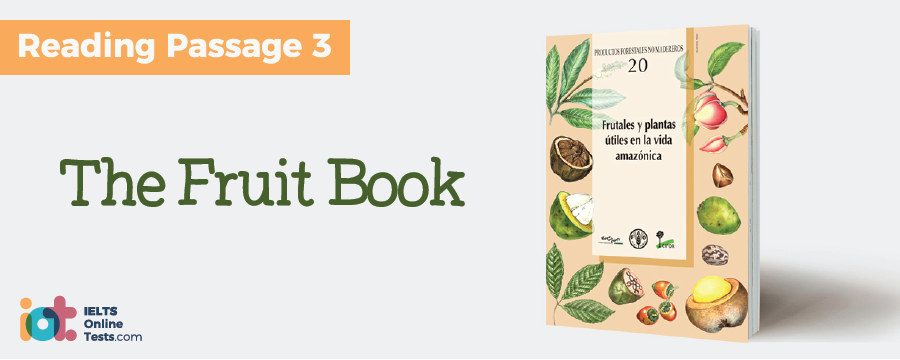
IELTS Recent Mock Tests Volume 1
- Published on: 06 Dec 2017
- Tests taken: 3,423,335
Answer Keys:
Part 1: Question 1 - 13
- 1 D
- 2 A
- 3 C
- 4 E
- 5 FALSE
- 6 TRUE
- 7 TRUE
- 8 FALSE
- 9 less
- 10 social
- 11 watched
- 12 observer
- 13 Nutcracker
- 1 D
- 2 A
- 3 C
- 4 E
- 5 FALSE
- 6 TRUE
- 7 TRUE
- 8 FALSE
- 9 less
- 10 social
- 11 watched
- 12 observer
- 13 Nutcracker
Part 2: Question 14 - 26
- 14 B
- 15 A
- 16 D
- 17 A
- 18 B
- 19 D
- 20 A
- 21 B
- 22 C
- 23 heat
- 24 denser
- 25 Great Ocean Conveyor
- 26 fresh water
- 14 B
- 15 A
- 16 D
- 17 A
- 18 B
- 19 D
- 20 A
- 21 B
- 22 C
- 23 heat
- 24 denser
- 25 Great Ocean Conveyor
- 26 fresh water
Part 3: Question 27 - 40
- 27 D
- 28 A
- 29 C
- 30 B
- 31 E
- 32 I
- 33 (forest) fruit/Fibre
- 34 (forest) fruit/Fibre
- 35 uxi
- 36 unpredictable
- 37 piquia (trees)
- 38 subsistence
- 39 commercial potential
- 40 non-timber forest products/NTFPs
- 27 D
- 28 A
- 29 C
- 30 B
- 31 E
- 32 I
- 33 (forest) fruit/Fibre
- 34 (forest) fruit/Fibre
- 35 uxi
- 36 unpredictable
- 37 piquia (trees)
- 38 subsistence
- 39 commercial potential
- 40 non-timber forest products/NTFPs
Review & Explanations:
Questions 1-4
Reading Passage 1 has seven paragraphs A-G.
Which paragraph contains the following information?
Write the correct letter A-G in boxes 1-4 on your answer sheet.
1 A comparison between rats’ learning and human learning
2 A reference to the earliest study in animal learning
3 The discovery of who stripped the pine cone
4 A description of a cost-effectiveness experiment
- 1 Answer: D
Keywords in Questions
Similar words in Passage
Q1: A comparison between rats’ learning and human learning
Urban black rats were found to lack the skill and were unable to learn it even if housed with experienced cone strippers. However, infants of urban mothers cross-fostered by stripper mothers acquired the skill, whereas infants of stripper mothers fostered by an urban mother could not.
Note:
Based on keywords “rat’s learning” and “human learning”, we can find out the needed information in paragraph D. After the writer mentioned urban black rats as unable to learn, he/she indicated the learning of infants or human. Moreover, between two objects did conjunction “However” used, so we figure out that above sentences is for comparison. Thus, the statement in Q1 must be contained in paragraph D.
- 2 Answer: A
Keywords in Questions
Similar words in Passage
Q2: A reference to the earliest study in animal learning
Learning Theory is rooted in the work of Ivan Pavlov, the famous scientist who discovered and documented the principles governing how animals (humans included) learn in the 1900s.
Note:
In the very first sentence, you are aware that Learning Theory is rooted in the work of Ivan Pavlov who discovered and documented the principles governing how animals learn. In other words, Ivan Pavlov is the one who discovered animal learning and then his work become the earliest study in animal learning. That referring to Learning Theory is a reference to the earliest study in animal learning. From that point, we figure out that the information should be contained in paragraph A.
- 3 Answer: C
Keywords in Questions
Similar words in Passage
Q3: The discovery of who stripped the pine cone
The culprit proved to be the versatile and athletic black rat ,(Rattus rattus), and the technique was to bite each cone scale off at its base
Note
Based on the keywords “strip” and “pine cone”, we figure out that the statement must be contained in paragraph C or D or E. After scanning paragraph C, we can find out the above sentence that is similar to the statement. As said in the paragraph, it is the versatile and athletic black rat that stripped the pine cone. For that reason, the answer must be paragraph C.
- 4 Answer: E
Keywords in Questions
Similar words in Passage
Q4: A description of a cost-effectiveness experiment
A good example of adaptive bearing we might conclude, but let’s see the economies
Note
Based on the keyword “cost-effectiveness”, you must skim to find out similar words. As scanning paragraph E, you realize the word “cost” repeated many times, and then the statement might be contained in this paragraph. In the first sentence, in addition, the writer mentioned “the economies” which indicates the cost-effectiveness. Hence, paragraph E must be the answer.
Questions 5-8
Do the following statements agree with the information given in Reading Passage 1?
In boxes 5-8 on your answer sheet, write
| TRUE | if the statement agrees with the information |
| FALSE | if the statement contradicts the information |
| NOT GIVEN | If there is no information on this |
5 The field trip to Israel was to investigate how black rats learn to strip pine cones.
6 The pine cones were stripped from bottom to top by black rats.
7 It can be learned from other relevant experiences to use a photocopier.
8 Stripping the pine cones is an instinct of the black rats.
- 5 Answer: FALSE
Keywords in Questions
Similar words in Passage
Q5:
The field trip to Israel was to investigate how black rats learn to strip pine cones.
the research reported in one paper started with a school field trip to Israel to a pine forest where many pine cones were discovered, stripped to the central core … was directed at finding out what was eating the nutritious pine seeds and how they managed to get them out of the cones.
Note:
Based on the keyword “field trip to Israel”, we can easily guess that the statement belongs to paragraph C. According to similar sentence, the field trip to Israel was directed at finding out what was eating the nutritious pine seeds. They did not know at first that it is black rats, so we cannot suppose the statement in Q5. All things considered, the answer is FALSE.
- 6 Answer: TRUE
Keywords in Questions
Similar words in Passage
Q6:
The pine cones were stripped from bottom to top by black rats.
The culprit proved to be the versatile and athletic black rat ,(Rattus rattus), and the technique was to bite each cone scale off at its base, in sequence from base to top following the spiral growth pattern of the cone.
Note
After scanning, we can find out the needed information for this question following Q5. According to that, black rats bit cones in sequence from base to top. In other words, the pine cones were stripped from bottom to top by black rats. Therefore, TRUE is the answer.
- 7 Answer: TRUE
Keywords in Questions
Similar words in Passage
Q7:
It can be learned from other relevant experiences to use a photocopier.
rather like our new photocopier which you can work out how to use once someone has shown you how to switch it on
Note:
After finding out similar words, it is apparent that the statement is true. What is more, we should recognize that as someone has shown us how to switch on a photocopier, it means that we are learning from their experiences. Thus, the answer must be TRUE.
- 8 Answer: FALSE
Keywords in Questions
Similar words in Passage
Q8:
Stripping the pine cones is an instinct of the black rats.
Urban black rats were found to lack the skill and were unable to learn it even if housed with experienced cone strippers
Note
Based on the keywords “black rats” and “stripping the pine cones”, we can find out the needed information. As shown, black rats were said to lack the skill and were unable to learn to strip the pine cones. Then, stripping the pine cones cannot be their instinct. Hence, FALSE is the answer.
Questions 9-13
Complete the summary below using words from the box.
Write your answers in boxes 9-13 on your answer sheet.
While the Nutcracker is more able to cache seeds, the Jay relies 9 on caching food and is thus less specialised in this ability, but more 10 . To study their behaviour of caching and finding their caches, an experiment was designed and carried out to test these two birds for their ability to remember where they hid the seeds.
In the experiment, the cacher bird hid seeds in the ground while the other 11 . As a result, the Nutcracker and the Mexican Jay showed different performance in the role of 12 at finding the seeds - the observing 13 didn’t do as well as its counterpart.

- 9 Answer: less
Keywords in Questions
Similar words in Passage
Tips for Q9-Q13:
With this kind of task, you are highly recommended to locate paragraphs in the passage where there are many similar words to keywords in the task. Your remaining duty is just finding out the suitable words to fill in the gap.
As a result, the needed information is in paragraph F and G.
Q9:
While the Nutcracker is more able to cache seeds, the Jay relies ________ on caching food
the Mexican Jay will also cache food but is much less dependent upon this than the Nutcracker.
Note
Firstly, the blank needs filling with an adverb.
As paragraph F and G discuss the Nutcracker and the Jay, we had better based on other keywords which are “relies” and “caching food”. After finding out the needed information, we are aware that the Jay relies less on caching food while the Nutcracker is more able to cache seeds. Hence, the answer must be “less”.
- 10 Answer: social
Keywords in Questions
Similar words in Passage
Q10:
and is thus less specialised in this ability, but more _______
The two species also differ in their social structure: the Nutcracker being rather solitary while the Jay forages in social groups.
Note
The blank needs filling with an adjective.
Following the flow of information. After having referred to the Nutcracker’s strength, the writer talked about the remainder’s strength. As scanning paragraph F, we realize the Jay’s strength is that they forage in social groups.
All in all, the blank should be filled with “social”.
- 11 Answer: watched
Keywords in Questions
Similar words in Passage
Q11:
In the experiment, the cacher bird hid seeds in the ground while the other _______
The design is slightly comical with a cacher bird wandering about a room with lots of holes in the floor hiding food in some of the holes, while watched by an observer bird perched in a cage.
Note
After finding out the needed information, we can easily fill the blank with appropriate word. As shown, the cacher bird hid seeds in holes while watched by an observer bird. As the other birds were considered as observer birds, the other watched cacher bird hid their seeds. Therefore, “watched” is viable for the blank.
- 12 Answer: observer
Keywords in Questions
Similar words in Passage
Q12:
As a result, the Nutcracker and the Mexican Jay showed different performance in the role of _______ at finding the seeds [...]
jay observers were as successful as jay cachers whereas nutcracker observers did no better than chance
Note
After finding out the needed information in the last paragraph, you can be confused with the word “cacher” and “observer” as choosing suitable word for Q12. Nevertheless, you should take notice of the word following “observing”. That means the needed word must be compatible with the following. Then, the blank in Q12 should be filled with “observer”.
- 13 Answer: Nutcracker
Keywords in Questions
Similar words in Passage
Q13:
As a result, the Nutcracker and the Mexican Jay [...] the observing _______ didn’t do as well as its counterpart.
jay observers were as successful as jay cachers whereas nutcracker observers did no better than chance
Note
Following information in Q12 and based on the phrase “didn’t do as well as”, we can figure out that it is the Nutcracker observers which did not do as well as its counterpart. All things considered, the appropriate word for Q13 must be “Nutcracker”.
READING PASSAGE 1
You should spend about 20 minutes on Questions 1-13, which are based on Reading Passage 1 below.

Learning by Examples
A Learning Theory is rooted in the work of Ivan Pavlov, the famous scientist who discovered and documented the principles governing how animals (humans included) learn in the 1900s. Two basic kinds of learning or conditioning occur, one of which is famously known as the classical conditioning. Classical conditioning happens when an animal learns to associate a neutral stimulus (signal) with a stimulus that has intrinsic meaning based on how closely in time the two stimuli are presented. The classic example of classical conditioning is a dog's ability to associate the sound of a bell (something that originally has no meaning to the dog) with the presentation of food (something that has a lot of meaning to the dog) a few moments later. Dogs are able to learn the association between bell and food, and will salivate immediately after hearing the bell once this connection has been made. Years of learning research have led to the creation of a highly precise learning theory that can be used to understand and predict how and under what circumstances most any animal will learn, including human beings, and eventually help people figure out how to change their behaviours.
B Role models are a popular notion for guiding child development, but in recent years very interesting research has been done on learning by examples in other animals. If the subject of animal learning is taught very much in terms of classical or operant conditioning, it places too much emphasis on how we allow animals to learn and not enough on how they are equipped to learn. To teach a course of mine, I have been dipping profitably into a very interesting and accessible compilation of papers on social learning in mammals, including chimps and human children, edited by Heyes and Galef (1996).
C The research reported in one paper started with a school field trip to Israel to a pine forest where many pine cones were discovered, stripped to the central core. So the investigation started with no weighty theoretical intent, but was directed at finding out what was eating the nutritious pine seeds and how they managed to get them out of the cones. The culprit proved to be the versatile and athletic black rat,(Rattus rattus), and the technique was to bite each cone scale off at its base, in sequence from base to top following the spiral growth pattern of the cone.
D Urban black rats were found to lack the skill and were unable to learn it even if housed with experienced cone strippers. However, infants of urban mothers cross-fostered by stripper mothers acquired the skill, whereas infants of stripper mothers fostered by an urban mother could not. Clearly the skill had to be learned from the mother. Further elegant experiments showed that naive adults could develop the skill if they were provided with cones from which the first complete spiral of scales had been removed; rather like our new photocopier which you can work out how to use once someone has shown you how to switch it on. In the case of rats, the youngsters take cones away from the mother when she is still feeding on them, allowing them to acquire the complete stripping skill.
E A good example of adaptive bearing we might conclude, but let’s see the economies. This was determined by measuring oxygen uptake of a rat stripping a cone in a metabolic chamber to calculate energetic cost and comparing it with the benefit of the pine seeds measured by calorimeter. The cost proved to be less than 10% of the energetic value of the cone. An acceptable profit margin.
F A paper in 1996, Animal Behaviour by Bednekoff and Baida, provides a different view of the adaptiveness of social learning. It concerns the seed caching behaviour of Clark's Nutcracker (Nucifraga columbiana) and the Mexican Jay (Aphelocoma ultramarina). The former is a specialist, caching 30,000 or so seeds in scattered locations that it will recover over the months of winter; the Mexican Jay will also cache food but is much less dependent upon this than the Nutcracker. The two species also differ in their social structure: the Nutcracker being rather solitary while the Jay forages in social groups.
G The experiment is to discover not just whether a bird can remember where it hid a seed but also if it can remember where it saw another bird hide a seed. The design is slightly comical with a cacher bird wandering about a room with lots of holes in the floor hiding food in some of the holes, while watched by an observer bird perched in a cage. Two days later, cachers and observers are tested for their discovery rate against an estimated random performance. In the role of cacher, not only the Nutcracker but also the less specialised Jay performed above chance; more surprisingly, however, jay observers were as successful as jay cachers whereas nutcracker observers did no better than chance. It seems that, whereas the Nutcracker is highly adapted at remembering where it hid its own seeds, the social living Mexican Jay is more adept at remembering, and so exploiting, the caches of others.











